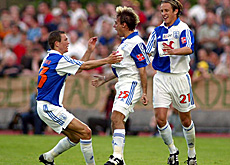Swiss football kicks off new era

Switzerland's professional football season got underway on Wednesday with a new name and a new format.
Rebranded as the “Super League”, Switzerland’s top division has been made smaller, simpler and hopefully more marketable.
To the casual observer, things might appear rosy in Swiss football right now. FC Basel’s heroics in the Champions League, Switzerland’s successful bid to co-host the 2008 European Championships and the frenzied eruption of new stadiums across the country all suggest a healthy state of play.
But further down the sport’s pecking order, there have been casualties. In the past 14 months alone, two former top division sides – Lugano and Lausanne – have gone bankrupt.
FC Sion, Swiss champions as recently as 1997, are currently striving to avoid a similar fate.
Of course, changing the name of Switzerland’s former National League A into the Super League will not in itself make things “super” overnight. But by slimming the top division down from 12 teams to ten and simplifying the championship format in line with other European models, national league officials insist that there will be benefits for clubs big and small.
“Like all other leagues, we are always looking for new sources of revenue which we can pass onto the clubs,” football league president Jean-François Kurz told swissinfo.
“Thanks to our new concept, we have been able to attract sponsorship from the Swiss energy company Axpo. I cannot reveal the amount of money involved, but I can say that it’s a large sum, in excess of anything we’d managed previously.”
More money
While Swiss football clubs should receive more league funding than ever before, they will also have to adhere to much tighter financial regulations. Clubs which fail to balance their books risk relegation or the loss of their league licences.
“With the Super League and the Challenge League (former Switzerland’s B-division) we now have two league championships with healthy financing and administration,” insists Kurz.
Despite its ambitious new name, the Super League is actually a good deal less exotic than its predecessor, the National League A, whose complexities would often bewilder Swiss football fans, let alone foreigners.
Under a format that somehow survived 16 years, the Swiss season was formerly divided into two separate winter and summer phases. At the end of the winter phase four teams would drop into a relegation play-off round while the remaining eight went on to contest the championship – having first had their winter points tally cut in half.
Although the halving of the points did increase the chances of having a close finish to the season, it certainly wasn’t the fairest or most readily understandable of systems.
“We really wanted to have a championship that put the emphasis on the best clubs competing for the title,” league marketing director Silvano Lombardo told swissinfo.
“The previous system focused far too much on the threat of relegation, which also forced many clubs to take great financial risks to make it past the winter cut-off point.
“The new format has meant breaking with tradition but I’m convinced that we now have a system that is fairer, more attractive to the media and to supporters, and much more sound financially.”
However, after deciding to make life less complicated in the country’s top division, the football league has introduced new levels of quirkiness to the former B-league.
Challenge League
The Challenge League, which guarantees promotion to the top division for at least one club each season, uses a unique format that most closely resembles a hybrid of league and cup competitions.
Under the new rules, teams will play each other home and away as usual. But then the scores of both games will be combined in the style of a knockout competition, with two extra “bonus points” going to the side which scored the most goals overall.
“We wanted to give the Challenge League a special position and mark it out as something entirely different from the Super League,” says Lombardo.
Despite the new names, new regulations, new formats and new sponsorship deal, most Swiss sports journalists seem convinced that the same two names will be leading the chase for the inaugural Super League title.
Having dominated the last three Swiss championships, Grasshoppers Zurich and FC Basel are once again expected to hog the top of the table this season.
For some of the smaller top division sides, the Swiss title is likely to remain little more than a fanciful dream. But if the league has done its homework properly, future financial nightmares should prove equally unlikely.
swissinfo, Mark Ledsom
Switzerland’s top division has been slimmed down from 12 clubs to ten.
The teams competing for the first “Super League” title are Grasshoppers Zurich, FC Basel, FC Zurich, Neuchâtel Xamax, Servette Geneva, Wil, St Gallen, Young Boys Bern, Thun and Aarau.
The former B-League has been renamed the Challenge League and will incorporate a unique blend of league and cup-style competition.
The Challenge League should involve 16 clubs, although FC Sion are challenging their current exclusion on financial grounds.
Wednesday’s results
FC Basel 2-1 FC Zurich
Servette 3-1 Wil
St Gallen 1-4 Young Boys
Thun 1-1 Aarau
Grasshoppers 0-1 Neuchâtel Xamax

In compliance with the JTI standards
More: SWI swissinfo.ch certified by the Journalism Trust Initiative



You can find an overview of ongoing debates with our journalists here. Please join us!
If you want to start a conversation about a topic raised in this article or want to report factual errors, email us at english@swissinfo.ch.